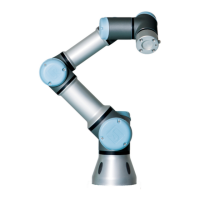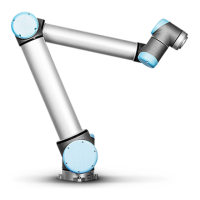14.5 Command: Move
14.5 Command: Move
The Move command controls the robot motion through the underlying waypoints.
Waypoints have to be under a Move command. The Move command defines the
acceleration and the speed at which the robot arm will move between those way-
points.
Movement Types
It is possible to select one of three types of movements: MoveJ, MoveL and MoveP
each explained below.
• moveJ will make movements that are calculated in the joint space of the robot
arm. Each joint is controlled to reach the desired end location at the same
time. This movement type results in a curved path for the tool. The shared
parameters that apply to this movement type are the maximum joint speed
and joint acceleration to use for the movement calculations, specified in deg/s
and deg/s
2
, respectively. If it is desired to have the robot arm move fast be-
tween waypoints, disregarding the path of the tool between those waypoints,
this movement type is the favorable choice.
• moveL will make the tool move linearly between waypoints. This means that
each joint performs a more complicated motion to keep the tool on a straight
line path. The shared parameters that can be set for this movement type are the
desired tool speed and tool acceleration specified in mm/s and mm/s
2
, respec-
tively, and also a feature. The selected feature will determine in which feature
space the tool positions of the waypoints are represented in. Of specific in-
terest concerning feature spaces are variable features and variable waypoints.
Variable features can be used when the tool position of a waypoint need to be
CB3 II-70 Version 3.4.5
Copyright © 2009–2017 by Universal Robots A/S. All rights reserved.

